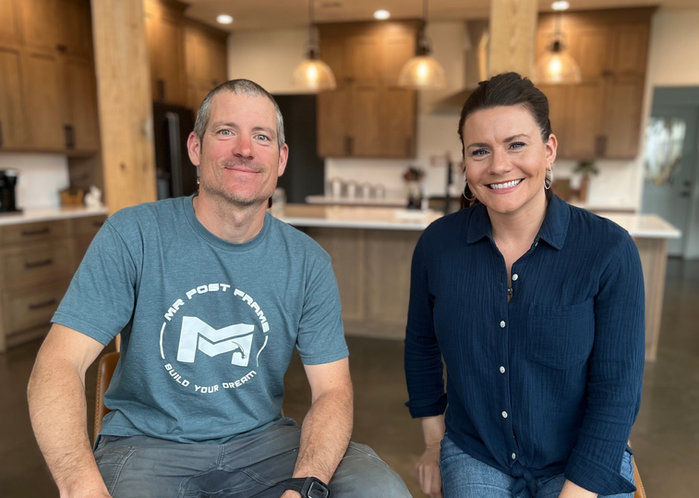Building a Porch Part 1| MAD County Standard | Part 11
- MR Post Frame
- Dec 25, 2023
- 3 min read
All right, welcome back to Mr. Post Frame. I'm Paul. Today's post will focus on working on a porch for this post-frame home. We'll break this into two posts, covering the porch construction for post-frame homes. We hope you find it interesting. Before we dive in, for those of you interested in self-building your post-frame home or building, we have a Patreon group. It's an awesome community where we discuss different topics every month. Check that out, and if you need design services, email us at design@mrpostframe.com. Now, let's jump into the show.
Determining Porch Height:

We start by measuring seven inches down from the bottom and strike a line across. This serves as our starting point for setting the porch height. Ensure the porch is a couple of inches below the floor. We mark four inches down from the initial line, which becomes the height of our brackets. When setting the zero point, ensure it aligns with the desired height, and use string lines for a level reference when setting the brackets later.
Setting String Lines:
The next step is to lay out the porch footing by using string lines, ensuring the distance from the grade board to the outside edge of the post is eight feet. This allows for an overhang of nine feet with an extra foot for concrete. We square up the ends and mark the posts' locations based on the string lines.
Digging and Pouring Porch Footings:

We then begin digging the porch footings at the marked locations, dealing with obstacles by hand digging and working through any challenges. Once the holes are ready, we bring in the concrete truck and pour the footings. We had filled a couple of our footings and realized how difficult it was to maneuver around to each footing so we opted to change and use a concrete bucket attachment for a skid loader. This made the process of pouring footing much smoother and quicker. As each footing was poured we would go through and smooth it out and level it off.
Setting Brackets:
Setting the brackets involves placing a 2x4 standing up so that it leaves a 4 inch gap underneath the footings. As you go, you want to ensure they align with the string lines for a level installation. With a little wiggling, they should slide in quite nicely.
Post Height Calculation:
We then calculate the post height by starting with the desired finished ceiling height and adjusting for the highest pier's position and bracket drop, using that as my zero.
Setting Posts:

Using green-treated six by six posts, we set them at the calculated heights and secure them in place. We determine the highest post's height by measuring from the bottom of the porch to the finished ceiling in the house. Adding the difference between the highest pier and the finished concrete gives us the starting measurement.
Setting Beams/Headers:
For the headers, we use 16-foot six by six posts, seam them in the middle, and secure them with structural lags into the posts. We continue by determining the baseline for the post and beam porch. Subtracting the beam's height, we establish the starting point for cutting the highest post at 107 and a quarter inches. For each subsequent post, we add or subtract the calculated difference.

We install sub-rafters across the porch, connecting them to the house using brackets and adding cross-bracing for stability. We install sub-rafters across the porch, connecting them to the house using brackets and adding cross-bracing for stability. The design includes six by six posts at the ends, reaching back to the house for additional support. We opt for a unique approach to porch rafters, taking them all the way out to the edge of the overhang. To achieve this, we use drop purlins and corresponding brackets, ensuring a clean and sturdy finish.
Review:
And now, let's delve deeper into the post and beam porch building process. We use green-treated six by six posts, which are actually five and a half inches by five and a half inches. The brackets we use, the SWP 66s, are specifically designed for six by six posts. We set all of our posts first and then seam our headers right at the top. The 16-foot six by six posts are seamed in the middle with structural lags down through the top into the posts, ensuring a sturdy construction. Stay tuned for the next post in which we continue the porch construction.
Thank you,
MR Post Frame

Patreon Group:
Interested in tackling your build on your own? If you want to explore the possibility of being your GC or self-building, our Patreon membership is for you! It's a community of like-minded people offering support, discounts, Q/A, and more.